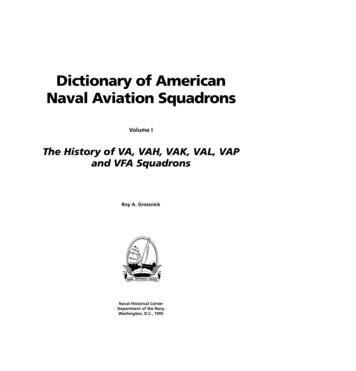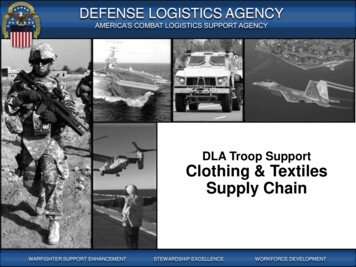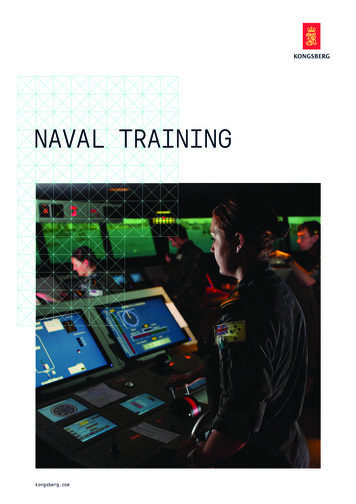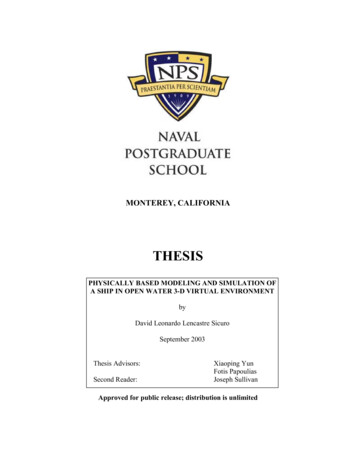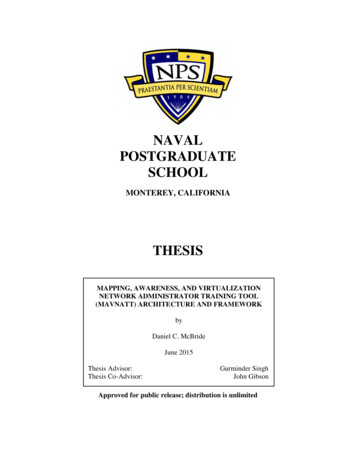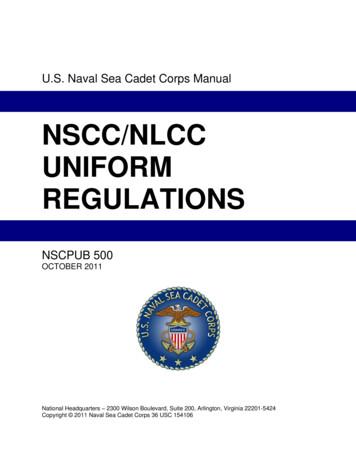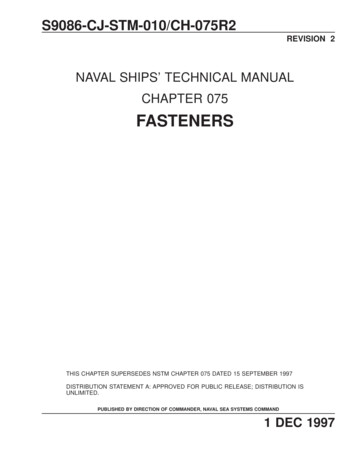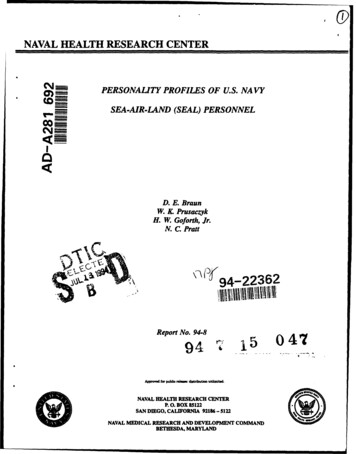
Transcription
NAVAL HEALTH RESEARCH CENTERPERSONALITY PROFILES OF U.S. NAVYSEA-AIR-LAND (SEAL) PERSONNELD. E. BraunW. XL PrusaczykH. W. Goforth, Jr.N. C. Pratt."94 22362Report No. 94-894Appwofor publc rom: duftbm5047unitd.NAVAL HEALTH RESEARCH CENTERP. 0. BOX 95122SAN DIEGO, CALIFORNIA 92186 - 5122NAVAL MEDICAL RESEARCH AND DEVELOPMENT COMMANDBETHESDA, MARYLAND
Personality Profiles of U.S. NavySea-Air-Land (SEAL) PersonnelD. E. BraunW. K. PrusaczykH. W. Goforth, Jr.N. C. PrattNaval Health Research CenterP.O. Box 85122San Diego, CA 92186-5122Report 94-8, supported by the Naval Medical Research and Development Command, Departmentof the Navy under work unit 62233N MM33P30.002-6005. The views expressed in this articleare those of the author(s) and do not reflect the official policy or position of the Department ofthe Navy, the Department of Defense, or the U.S. Government. Approved for public release;distribution is unlimited.
SUMMARYProblem.High (50-70%) attrition rates among U.S. Navy Sea-Air-Land commando (SEAL) traineesare common. Although SEAL volunteers are selected for intelligence, maturity, combat skillsand physical performance, these characteristics are insufficient for predicting success or failureduring training.Objective.The primary objective of this study was to collect baseline demographic and personalitydata on SEALs for developing a profile that may be used to improve selection and training.Demographic and personality data were collected from 139 SEAL personnel (aged 20-45)assigned to five different duty stations. The NEO Personality Inventory was employed becauseof its breadth and applicability. This inventory categorizes personality by five major domains:Neuroticism, Extraversion, Openness, Agreeableness, and Conscientiousness. Data were analyzedfor effects of age, rank and experience in Naval Special Warfare.SEAL data were alsocompared to those collected from adult males in the general population.Results.The more-experienced SEALs scored higher on Conscientiousness and lower onExtraversion than the less-experienced SEALs.However, these effects were shown to beexplained by increased age, not Special Warfare experience per se. Commissioned officersscored significantly higher on both Extraversion and Conscientiousness than Enlisted SEALs.SEALs scored lower in Neuroticism and Agreeableness, average to lower in Openness, and higherin Conscientiousness and Extraversion compared to the norms for adult males.Aooeslon ForNTI GRA&IDTICGABoUriannowieed02Avs" i ,At,Ce"*., a"t .- , ',
Conclusions.Based on the personality data collected, a general profile for the "average" SEAL wascreated. This profile may be useful in developing future recruitment, selection, and trainingprograms. One consideration for further study is the question of whether the differences foundbetween SEALs and the general population norms are due to self-selection or to personalitychanges caused by the demands of military and SEAL training.3
INTRODUCTIONU.S. Navy Sea-Air-Land (SEAL) personnel are special warfare operators who frequentlyconduct missions in the harshest environments. Motivation, training, and the high quality ofthese personnel contribute to their readiness for specialized missions of national or globalsignificance (Stiner, 1992). The SEAL training course is so arduous that 50-70% attrition ratesare common.Select groups of Army Special Forces (SF) and SEAL personnel have distinctly differentpersonalities than the average civilian (CDR Peter Graham- Mist, MSC, USN, personalcommunication, 1993). However, little formal investigation addressing the personality of thesepersonnel has been conducted. One study of U.S. Army SF personnel employed an interviewprocess (Manning & Fullerton, 1984). Another study recorded comparative biographic histories,focusing on social development, of Navy divers (Biersner, 1973). These authors reported nosignificant differences between the personalities of these personnel and those of conventionalmilitary personnel.A few studies suggest that personality inventories are more useful than interviews inpredicting success in challenging military training programs. Jessup and Jessup (1971) found arelationship between the success of British Royal Air Force trainees and scores on Eysenck'sPersonality Inventory, which measures degrees of extraversion and neuroticism. The DynamicPersonality Inventory, which measures social dimensions of personality, effectively determinedcharacteristics of successful bomb disposal trainees in Northern Ireland (Cooper, 1982). TheHogan Personality Inventory (HPI) (Hogan, 1986) was used to predict success of U.S. Navypersonnel during a winter tour in Antarctica (Biersner & Hogan, 1984). The HPI consists of sixprimary scales of broad personality characteristics, six empirical scales of occupationalperformance, and one scale to validate testing protocols.McDonald, Norton, and Hodgdon (1988) administered the HPI, along with several otherquestionnaires, to a group of Basic Underwater Demolition/SEAL (BUD/S) students at thebeginning of training, and again to those who completed training six months later. Thosestudents who graduated scored significantly higher on the HPI scales for Adjustment, Likability,Service Orientation, and Managerial Potential than those who dropped out of training.Surprisingly, when graduates were retested later, they showed significant decreases in scores for4
likability, Reliability, Service Orientation, and Validity compared to pretraining scores. Theauthors suggested that these results may have been due, in part, to inflated pretraining scoresfrom subjects who felt compelled to respond as they judged BUD/S students would be expectedto, and that this pressure diminished by graduation. Other studies have compared HPI resultsamong BUD/S dropouts, BUD/S graduates, and experienced SEALs (McDonald et al., 1988;Beckett, M.B., Hodgdon, JA. & Goforth, H.W., unpublished data). SEALs scored significantlyhigher than both other groups on Adjustment, and higher than BUD/S dropouts on Intelligence,Prudence, Likability and Validity. Interestingly, SEALs scored lower than BUD/S graduates onAmbition.The NEO Personality Inventory (NEO-PI) is a more recently developed inventory basedon 25 years of research focusing on a five-factor model of personality (Costa & McCrae, 1989a;1989b).This model divides personality traits into five broad domains:Neuroticism,Extraversion, Openness, Agreeableness, and Conscientiousness. Personality is described in termsof the degree to which each domain is exhibited, and of the combination of scores acrossdomains. This personality model has received strong empirical validation by both researchersand clinicians (Conoley & Kramer, 1989), and has been judged as a useful tool in the fields ofpersonnel selection, training and development, and performance appraisal (Barrick & Mount,1991). The NEO-PI also incorporates several scales that relate to those of the HPI found todiscriminate between successful and unsuccessful BUD/S students (McDonald et al., 1988). TheHPI Adjustment scalepurports to measure "self confidence and freedom from anxiety."Similarly, the NEO-PI Neuroticism scale measures "adjustment vs. emotional instability,"including anxiety. HPI's Likability scale measures "the extent to which individuals are cordialand even tempered."The NEO-PI's Extraversion and Agreeableness scales also addressinterpersonal interactions and sociability. Finally, the HPI's Managerial Potential scale predicts"leadership ability, planning and decision-making skills"; and the NEO-PI's Conscientiousnessscale purports to measure "degree of organization, persistence and motivation in goal-directedbehavior."Since the NEO-PI is now well established in personality profiling and is shorter than theHPl, it seemed a logical instrument to profile SEALs. The NEO-PI manual supplement (Costa& McCrae, 1989b) includes a personality profile derived from a large sample of adult males (215
85 years). These norms were selected as standards against which data collected from SEALswould be compared.This study examined the personality profiles of U.S. Navy SEALs. The purpose was toprovide accurate baseline data from which SEAL selection and training programs could bedesigned. In the future, the NEO-PI may be used in the selection of applicants most likely tosucceed during training as SEAL operators.METHODSSubjectsPotential subjects at Naval Special Warfare (NSW) commands were briefed on thebackground and purposes of the study. A total of 139 SEALs from SEAL Teams Two (ST-2),Three (ST-3), Four (ST-4), Five (ST-5), and SEAL Delivery Vehicle Team Two (SDVT-2)volunteered as subjects, giving written informed consent. The sample consisted of 114 (82%)enlisted and 25 (18%) commissioned officers. They were equally distributed between East (n 68) and West (n 71) Coast SEALs.MeasuresPrior to completing the NEO-PI, each subject provided basic demographic information.Subjects were given as much time as needed to complete the NEO-PI, Form-S (Self-Report)(Costa & McCrae, 1989a). The NEO-PI consists of 181 items answered on a five-point scale:strongly disagree, disagree, neutral, agree, strongly agree. The NEO-PI measures five domainsor dimensions of personality. Costa and McCrae (1989a) describe the domains as follows:1. Neuroticism assesses adjustment vs. emotional instability.Identifiesindividuals prone to psychological distress, unrealistic ideas, excessive cravingsor urges, and maladaptive coping responses.2. Extraversion assesses quantity and intensity of interpersonal interaction,activity level, need for stimulation, and capacity for joy.3. Openness assesses proactive seeking and appreciation of experience for its ownsake, and toleration for and exploration of the unfamiliar.4. Agreeableness assesses the quality of one's interpersonal orientation along acontinuum from compassion to antagonism in thoughts, feelings, and actions.5. Comscientiousmus assesses the individual's degree of organization, persistence,and motivation in goal-directed behavior. Contrasts dependable, fastidious peoplewith those who are lackadaisical and sloppy.6
The Neuroticism, Extraversion, and Openness domains are further divided into measurable facetsin the NEO-PI.AnalysesMeans and standard deviations were calculated for each domain and facet. Profiles ofenlisted SEALs were compared to commissioned officers, and the effects of age and experienceamong SEALs were considered as well. SEAL domain scores were converted to McCall's Tvalues using the NEO-PI manual means and standard deviations for adult males. Data wereanalyzed using SPSS-X (SPSS Inc.; Chicago, IL).Two-taled t-tests or analyses of variance(ANOVA) were performed, as appropriate, for comparison among groups. A probability levelof 0.05 was selected to evaluate statistical significance.RESULTSDemo2rahic InformationThe SEALs participating in this study had a mean ( SD) age of 27 (. 6) years rangingfrom 20 to 45 years. The average age on entering military service was 19 ( 2) years. TheseSEALs' NSW experience ranged from 1 to 27 years with an average of 5 ( 5) years.The age distribution of SEALs reflects the U.S. Navy's enlistment and NSW selectioncriteria. The youngest enlistment age in the U.S. military is 17 years, and the maximum age forselection for SEAL training is 28 years. Thus, the age distribution for SEALs is positivelyskewed. The distribution of number of years of NSW experience was skewed as well, a patterntypical for many military populations. Once joining NSW, SEALs have an obligation of sixyears. Those with more than six years of NSW experience had chosen to re-enlist.A majority (58.8%) of these SEALs joined the military with a high school diploma (Table1). Approximately 23% had college experience when they joined the military, and approximately11% held a degree. At the time of the study, 28% had some college experience, and nearly 31%held either an Associate's or Bachelor's degree.7
Table 1. Education levels of U.S. Navy SEALs (percentages based on those responding).EDUCATION LEVELAT ENLISTMENTCURRENT (n 134)(n 114)NO. REPORTING (%)NO. REPORTING (%)8 (7.0)4 (3.0)High School Diploma67 (58.8)51(38.1)1 year of College14 (12.3)18 (13.4)2 years of College10 (8.8)16 (11.9)Associate's Degree1 (0.9)9 (6.7)3 years of College2 (1.8)4 (3.0)Bachelor's Degree12 (10.5)32 (23.9)G.E.D.NEO-PIAnalyses of variance of the demographic data revealed only one significant differenceamong personality domains or facets on the NEO-PI among Agreeableness scores obtained fromSEALs at different locations (p 0.05).A Duncan's multiple range test revealed thatAgreeableness scores from SEALs at both ST-2 and SDVT-2 (East Coast) were significantly (p 0.05) lower than those from SEALs at ST-3 (West Coast).The subjects were divided into two groups, based on NSW experience, to identifydifferences in NEO-PI responses. Group I (n 107) was comprised of those with up to andincluding six years experience, and Group II (n 31) of those with seven or more years of NSWexperience.The mean age of the two groups (25 and 35 years, respectively) differedsignificantly (p 0.01); therefore, a two-factor ANOVA was performed using age as aconcurrently processed covariate with experience.Group II scored significantly higher on the Conscientiousness domain than Group I (p 0.01).However, the difference was solely attributable to the increased age (p 0.01), notexperience, of Group II. The difference between the Extraversion scores of the two groupsapproached significance (p 0.06); the lower score for Group II was again due to age (p 0.05).The difference in Extraversion scores was attributable to lower scores for the Excitement-Seeking8
(p 0.05) and Gregariousness (p 0.01) facets among Group II. Differences found within thesetwo facets were also attributable to age, not experience (p 0.01 and p 0.01, respectively).NEO-PI results of commissioned officers were compared to those of enlisted personnelusing a two-tailed t-test (Table 2). Commissioned officers scored significantly higher on bothExtraversion (p 0.01) and Conscientiousness (p 0.01). The difference on the Extraversiondomain was attributable to significantly higher scores for Assertiveness (p 0.01) and Activity(P 0.01).Table 2. Mean scores for Enlisted and Commissioned Officers on NEO-PI Extraversion andConscientiousness domains.DOMAIN/FacetENLISTEDCOMMISSIONED(n 114)(n 21129.3623.6022.04CONSCIENTIOUSNESS53.0858.40The domain and facet means and the statistical significance of comparisons betweenSEALs and adult males are presented in Appendix A.Most comparisons show significant differences in mean values of domains/facets betweenSEALs and adult male norms. However, since the range of scores which are classified as "veryhigh," "high," "average," "low," or "very low" by Costa & McCrae (1989b) are very broad, asignificant difference in means does not necessarily indicate a difference in the general categoryinto which the means fall. Much depends upon how the SEAL data were distributed. MeanSEAL domain scores were converted to T-scores and their distribution compared to the T-scoresprovided for adult males (Costa & McCrae, 1989b) (Figure 1).9
90*MALE ADULTNORMS*80.*A .TVery70* SHighi-.60FLH"igso0Average0V Low*30,Very Low20100104NE0ACDOMAINFigure 1. Box plot of SEAL T-score distribution against profile norms for adult males. Rawscores were converted to T-scores using norm mean and standard deviation. The line throughthe box represents the median value, and the notch in the box is the 95% confidence bandabout the median. The bottom and top of the box represent the 25th and 75th percentiles,respectively. The bottom and top vertical lines correspond to the 10th and 90th percentiles,respectively. The black circles represent the lowest and highest scores. On the x-axis, N Neuroticism; E Extraversion; 0 Openness; A Agreeableness; C Conscientiousness.DISCUSSIONThe results of the NEO-PI provide important data relevant to the construction of apersonality profile of the successful U. S. Navy SEAL When interpreting results from the NEOPl, however, several points should be kept in mind. As with the HPI, the NEO-PI domain andfacet scales approximate normal distributions. A high score suggests a higher probability thatthe feature/behavior associated with that trait will be apparent. However, a low or average scoreon any scale can be as informative as a high score. The overall profile is derived from acombination of scores from all domain and facet scales, not from one isolated score.10
The most meaningful differences between less experienced and more experienced SEALswere most likely attributable to maturity, rather than NSW experience. The more mature SEALsscored slightly lower in Extraversion.This appeared to be attributable to lower scores inGregariousness and Excitement-Seeking, suggesting that the more mature SEALs did not seekas much social stimulation or excitement as the younger SEALs. The more mature SEALs alsoscored significantly higher on the Conscientiousness scale, suggesting that they may have beenmore persistent, dependable, and/or well-organized than the younger SEALs.Interestingly, SEAL officers scored higher than enlisted personnel on the Extraversiondomain. In this case, however, the differences in Extraversion were apparently due to higherscores in the Assertiveness and Activity facets. Note that the aforementioned decrease inExtraversion among more mature SEALs was due to their lower scores for Gregariousness andExcitement-Seeking. These data suggest that SEAL officers are more assertive, confident, andforceful than enlisted SEALs; manifesting a more active, vigorous personal style. SEAL officersalso scored higher on the Conscientiousness scale, indicating they are more organized, persistent,and reliable than enlisted personnel. These results do not indicate that enlisted personnel areunreliable, rather that commissioned officers appear to display these characteristics to a greaterextent. Officers, especially SEAL officers, need to be assertive, active, and conscientious sincethey assume responsibility for the lives of those they command. Determining whether thesedifferences reflect self-selection or the influence of officer candidate school and SEAL trainingon officer personality traits was not addressed by this study.The mean SEAL score for Openness, while significantly higher than that of adult males, fellwithin the "average" range when plotted on the adult male profile. Openness is especiallyimportant in training indicating an individual is "training ready" (Barrick & Mount, 1991). Thisis important considering the dynamic training requirements of the Navy SEAL. The SEALs' highExtraversion score was attributable to high scores in the Assertiveness, Activity, and especiallythe Excitement-Seeking facets (Table 3). Excitement-Seeking was the only SEAL domain orfacet score in the "very high" region of the adult male profile. Only six SEALs scored at orbelow the adult male mean, and the SEAL mean was nearly eight points higher. However,Excitement-Seeking scores for SEALs appeared more normally-distributed than those of theVulnerability facet, and extreme scores did not appear truncated, suggesting that this scale covers11
the range of SEAL responses.Generally, SEALs scored lower in Neuroticism andAgreeableness, average in Openness, and higher in Extraversion and Conscientiousness comparedto the norms for adult males. The low scores in Neuroticism are most extreme within theDepression and Vulnerability facets. These scores indicate that SEALs are less prone to feelingsof guilt, sadness, or loneliness, and are more independent and capable of handling difficultsituations than males in the general population. The low SEAL scores in Agreeableness werenot surprising, because a low score indicates a tendency for one to fight for one's interests, anintegral characteristic of NSW personnel. The high Extraversion sccre of SEALs is due primarilyto high scores on the Assertiveness, Activity and Excitement-Seeking facets. Extraversion hasbeen reported to be important in training procedures especially in tasks requiring high energyactivity such as police academy training. These characteristics indicate that SEALs are morelikely to be forceful, energetic, and to become leaders than men of the general population. Theaverage SEAL is also more persistent, reliable, and scrupulous, viewing life as a series of taskoriented challenges, as suggested by their high scores on the Conscientiousness domain.SEAL scores were similar to adult male scores in four areas:the Hostility andImpulsiveness facets of the Neuroticism domain; and the Feelings and Values facets of theOpenness domain. These similarities might indicate that SEALs present an average range of selfcontrol, temperament, and demeanor in their personalities.The results of this study offer useful insight for those designing training programs forSEALs, and point out important differences between SEALs and males of the general population.The data also support the et *er work by McDonald, et al. (1988) suggesting certaincharacteristics of a SEAL candidate, such as the amount of extraversion, vulnerability, activity,and excitement-seeking, might predict success or failure during training.Barrick and Mount (1991) found that Conscientiousness was a consistently valid predictorfor job performance among many occupational groups (professionals, police, managers, sales,skilled/semi-skilled). Individuals who scored high on measures of persistence, obligation, andsense of purpose generally performed better on the job than those who did not. As Barrick andMount (1991) also pointed out, Openness was a valid predictor for training proficiency and mightbe useful in determining SEAL applicant selection. Ryman and Biersner (1975) have found thathigher scores in Openness were an indicator of success in Navy Dive School Training.12
Individuals who score high on Openness are likely to have positive attitudes toward learningexperiences in general. There was no correlation found in the 1991 study between Agreeablenessscores and job performance. Thus, traits such as courtesy, compassion, and generosity may beless important than assertiveness, confidence, and activity to job performance in general, and tothe successful SEAL student in particular.Using guidance provided by the NEO-PI authors (Costa & McCrae, 1989a), the followingdescription of "average" U.S. Navy SEALs was generated:This subset of SEALs appear to be calm, hardy, secure, and not prone to excessivepsychological stress or anxiety. They are level-headed, practical and collectedeven under very stressful or dangerous situations. They are rarely impulsive andhave strong control over cravings or urges. Active and assertive, they prefer beingin large groups and are usually energetic and optimistic. They seek excitementand stimulation and prefer complex and dangerous environments. They are verycompetitive, skeptical of others' intentions, and are likely to aggressively defendtheir own interests, but are not hostile. Finally, they are purposeful, wellorganized, persistent, and very reliable.One intriguing question is left unanswered: Are the differences between SEALs and the generalmale population due to self-selection or to the intense demands of military and SEAL training?It is possible that the lure of such a dangerous, exciting lifestyle attracts those predisposed tosucceed in that environment. On the other hand, it is also possible that the intense training andlifestyle itself might influence the personality of those experiencing it. The results of McDonald,et al. (1988) suggest, inconclusively, that some personality changes may occur during SEALtraining. Future research should attempt to verify these conclusions using the NEO-PI. The datacollected could be more definitive and useful if the tests were administered to SEAL individualsapplying for BUD/S at initiation of BUD/S training, those who drop out of training, graduates,and finally, to non-SEAL military personnel at corresponding stages of their careers. The resultsof such studies, when controlled for the effects of increasing age, would elucidate the effects, ifany, of SEAL training on personality changes, and help identify the essential personality traitsof the successful SEAL.13
REFERENCESBiersner, R. J. (1973). Social development of Navy divers. Aerospace Medicine, 44, 761-763.Biersner, R. J., & Hogan, R. (1984). Personality correlates of adjustment in isolated workgroups. Journalof Research in Personality,18, 491-496.onoley, J. C., & Kramer, J. J. (1989). Mental measurementsyearbook (10th ed.) (pp. 346-351).Lincoln, Nebraska: University of Nebraska Press.Costa, P. T., Jr., & McCrae, R. R. (1989). NEO personalityinventory manuaL Odessa, Florida:Psychological Assessment Resources, Inc.Costa, P. T., Jr., & McCrae, R. R. (1989). NEO PI/FFImanual supplement. Odessa, Florida:Psychological Assessment Resource.Hogan, R. (1985). Personalityinventory manual. Minneapolis, Minnesota: National ComputerSystems, Inc.Jessup, G. & Jessup, H. (1971). Validity of the Eysenck personality inventory in pilot selection.OccupationalPsychology, 45, 111-123.Manning, F.J., & T. D. Fullerton. (1984). Personal and organizational factors affecting healthand morale of US Army Special Forces soldiers. Proceeding of the Symposium:Psychology in the Department of Defense (pp. 232-236). Colorado Springs, Colorado.McDonald, D. G., Norton, J. P., & Hodgdon, J. A. (1988). Determinantsand effects of trainingsuccess in U.S. Navy specialforces (Report No. 88-34). San Diego, California: NavalHealth Research Center.Stiner, C.W. (1992). Special Ops: unprecedented risks, opportunities ahead. Defense 92.May/June, 29-38.14
APPENDIX A15
Means (it) and standard deviations (sd) of NEO-PI domain and facet scores for U.S. Navy SEALscompared to norms provided for adult males by Costa and McCrae (1989b). Two-tailed tvaluesand significance levels (p)shown for comparisons of SEAL means to the adult male norms (nsnonsignificant).-DOMAIN/FacetSEALE(a-139)Adult Male rtivenessActivityExcitement-SeekingPositive 16
REPORT DOCUMENTATION PAGEmUOAi Men.Ohmmrm. u-m- 9.Sdmi hot e§ig Vmm mdw . and eulpO mid mHuj*W Nm 9Wa#"d ,m br mEmf OdemjI d0ofmmnb.mW,We 12D04. Mblpn. VA DI243. tm VCm i IabaafWooAipa1215 .SMkmnDufNtIdidniON #indms. ginie, OwMW -m aa of swa SWpnwwmuiboWtomOdI. AGENCY USE ONLY (Lew bft)2. REPORT DATEI4.TILE AND SUBTE1994Ma3. RfORf TYPE AND DATE COVERED1992-1993";FUNDING NUMBERS 62233N'.Personality Profiles of U.S. Navy Sea-Air-Land(SEAL) PersonnelProgram Eement:m3 3 P3 0 .0Work Unit Number: 6005Braun, D.E., Prusaczyk, W.K., Goforth, H.W., Jr., Pritt, N.C.S. PERFORMING ORGANIZATION7. PERFORMING ORGANIZATION NAME(S) AND ADDRESS(ES)Report No.Naval Health Research CenterP. 0. Box 85122San Diego, CA 92186-51229. SPONSORINGIMONITORING AGENCY NAMES) AND ADDRESSES)Naval Medical Research and Development CommandNational Naval Medical Center94-810. SPONSORINGIMONITORINGAGENCYREPORTNUMBERBuilding 1, Tower 2Beehpd. M 20RRQ-qn/A11. SUPPLEMENTARY NOTES12b. DISTRIBUTION CODE12L DISTRIBUTIOWAVAILABIUTY STATEMENTApproved for public release; distribution isunlimited.13. ABSTRACT (Afxtumw200 wou)One hundred thirty-nine U.S. Navy Sea-Air-Land (SEAL) personnel completed the31O Personality Inventory (NEO-PI). The average profiles were compared to adultmale norms f or five broadly defined domains. SEALs scored lower in Neuroticismand Agreeableness, average in Openness, and higher in Extraversion andHigh Extraversion andConscientiousness compared to these two populations.Conscientiousness scores have been shown to predict job performance in otherprofessions. SEALs seek excitement and dangerous environments, but are otherwisestable, calm, and rarely reckless or impulsive. Although this average profilemay not characterize any individual SEAL, we believe this study provides the mostcomprehensive personality profile of Navy SEALs to date.15. NUMBER OF PAGES14. SUBJECT TERMSNavy SEAL; NEO Personality Inventory;profile17. SECURITY CLASSIFICATION OF REPORTUnclassifiedNSN 7540-01-M50018. SECURITYCLASSIFICATION OF THIS PAGEUnclassifiedpersonality;16. PRICE CODE16ji. SECURITYCLASSFICA2 D.UMrTATION OF ABSTRACTTION OF ABSTRACTUnclassifiedUnlimitedSWd Form 2s (Rev. 24)PremhedybyANSISh t9-182W 102
Hogan Personality Inventory (HPI) (Hogan, 1986) was used to predict success of U.S. Navy personnel during a winter tour in Antarctica (Biersner & Hogan, 1984). The HPI consists of six primary scales of broad personality characteristics, six empirical scales of occupational
